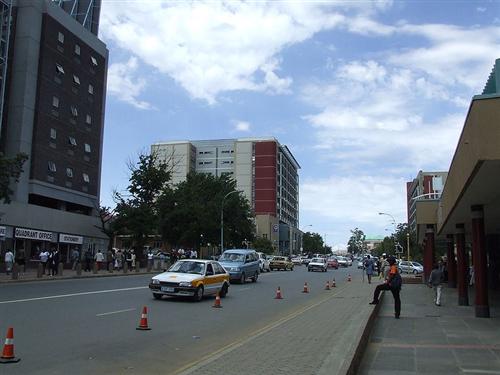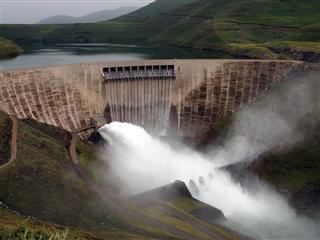Basic data
The mountain kingdom of Lesotho, or the Kingdom in the Sky as it is sometimes known, is a land-locked country entirely surrounded by South Africa. Lesotho is also completely encompassed by the Orange-Senqu River basin and water is considered to be one of its most valuable natural resources. The majority of Lesotho’s population lives in small mountain villages in the Drakensberg mountains and the rural areas of the western lowlands where subsistence farming is a primary activity. Lesotho has a population of 1,925 million, dominated by the BaSotho cultural group (99,7%).
The capital, Maseru (population approximately 195 000), lies near the border with South Africa, in Lesotho’s western lowlands, where most of the country’s population lives. The population is young, with a median age of 22,9 years in 2011. Lesotho, like all southern African countries, has a high HIV prevalence rate at 23,6% for adults in 2009. The Human Development Index (HDI) for Lesotho is 0,450, ranking the country 160th out of 187 countries with data (UNDP HDR 2011).

Kingsway, the main road passing through the CBD of Maseru Lesotho.
Source:Denne 2006
( click to enlarge )
Challenges for Development
Lesotho is a mountainous kingdom where most of the population lives in rural areas. Although surrounded entirely by South Africa it has remained largely isolated from modern technology until the 1990s, when the Lesotho Highlands Water Project (LHWP) began. Villages are scattered in the Drakensberg Mountains and in the western lowlands where some can only be accessed on horseback, light aircraft or by foot. The economy of the country depends mainly on subsistence farming, manufacturing and remittances from migrant labourers in South African mines.
Only around 10% of the soil can be used for agriculture. But the agricultural sector, which accounts for about 8,4% of GDP, is the primary source of income, or an important supplementary source, for more than half of the population in rural Lesotho. Around 85% of the local population is engaged in some kind of subsistence agriculture. Overgrazing has degraded soil quality and erosion is an increasing problem.
Migrant workers in South African mines, through their remittances, have allowed households to reduce their dependence on agriculture while making investments to supplement farming activities. About one third of the economically active males are working in South Africa. There has, however, been a steady fall in remittances from abroad, due to job scarcity in South Africa.
Recently Lesotho, to a degree, has developed an industrial manufacturing sector, in particular textiles, clothing, footwear and construction. In 2010, industry contributed 33,9% of the GDP.
The Lesotho Highlands Water Project and the huge investment associated with it have a significant impact on the Lesotho’s political economy, including the rural economy. The Lesotho government, as a result of royalty payments, could finance development-oriented programs and create a steady income stream by investing royalties in Lesotho and abroad.
Phase 1A of the project provided employment to more than 7 000 people, resulting in R400 million worth of earnings. On the other hand, the project resulted in loss of both arable and grazing land, and required resettlement and relocation of households, impacting mostly rural communities since their income is mostly derived from agriculture.
Within an extreme poverty affecting the majority of the population health issues belong to the most serious challenges. Apart from the high HIV-prevalence Lesotho has the world’s fourth-highest tuberculosis incidence – an estimated 696 tuberculosis patients per 100 000 population (WHO 2007). Chronic malnutrition of children under 5 years, vitamin A deficiency and goitre (enlargement of the thyroid gland caused by an iodine deficiency) are also health problems, among children especially, in Lesotho.
 Katse Dam, the keystone of the Lesotho Highlands Water Project. Source:Kruchem 2011 ( click to enlarge ) |
Poverty Reduction Efforts
Lesotho’s Poverty Reduction Strategy (PRS) aims to provide a sustainable broad-based improvement in the welfare of the current generation without compromising opportunities for future generations. The aim is to develop economically and technologically while exercising strong environmental stewardship. The Strategy has a National Vision that by the year 2020 Lesotho will be a stable democracy, united and at peace with itself and its neighbours. The PRS is built on three inter-connected approaches:
(a) Rapid employment creation through the establishment of a conducive operating environment that facilitates private sector-led economic growth
(b) Delivery of poverty-targeted programmes that empower the poor and vulnerable and enable them to secure access to income opportunities
(c) Ensuring that policies and legal framework are conducive to the full implementation of priorities, that bureaucratic constraints are removed, and that the productivity of the public sector improves”
Improved infrastructure for water supply to urban and rural areas is an important component of Lesotho’s efforts to reduce poverty. Another priority is developing better water-harvesting and irrigation techniques to increase the availability of water and to use water more efficiently.
To find out about Lesotho's progress towards achieving its development goals, please refer to the Human Development Indicators pages of this theme.
